Sourdough French bread is a simple and classic recipe with a fluffy texture and crusty exterior. Knead the night before and allow it to ferment overnight, then shape, rise, and bake the next day. It’s wonderfully simple.
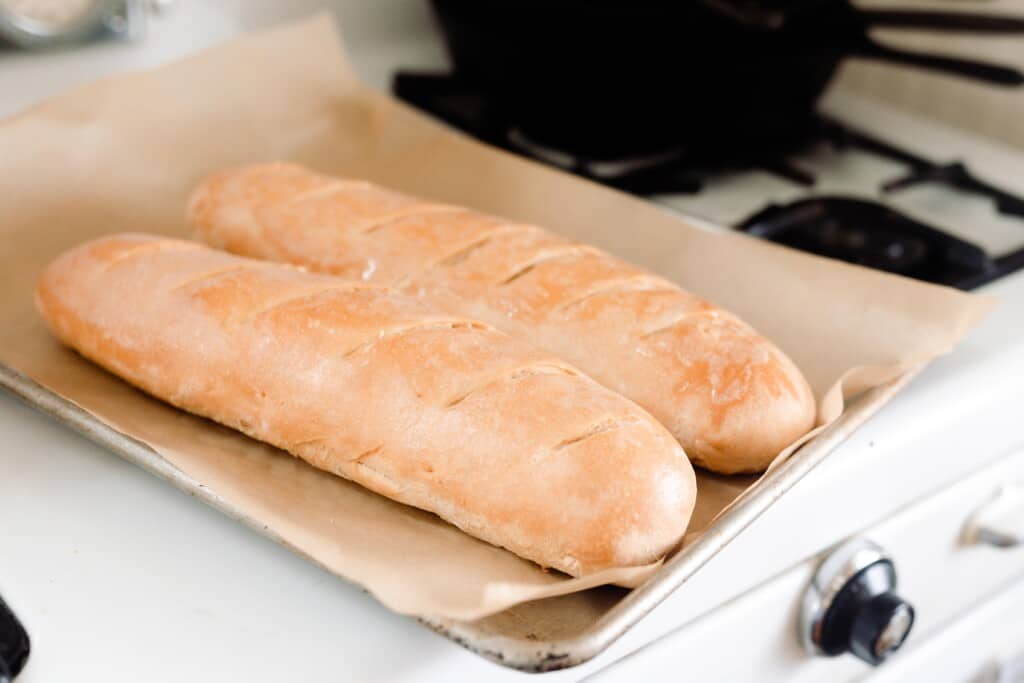
There is nothing better than a crusty loaf of bread. Slice it thick and spread with homemade butter, and now you are speaking my language.
Most French bread recipes call for instant yeast, which I almost never keep in my pantry, except for that rare occasion I want to make this einkorn sandwich bread.
Once you switch to fermenting grains and using wild yeast to leaven bread, it’s hard to go back to the conventional fast-rising breads. It lacks the flavor that develops during that slow rise.
But it is a delicate balance, because that fluffy center can sometimes be a challenge to perfect with sourdough.
These sourdough French baguettes have all the good qualities one can hope for. Crusty outside with a fluffy, tender texture inside. It’s perfect to serve as garlic bread, or with a bowl of soup.
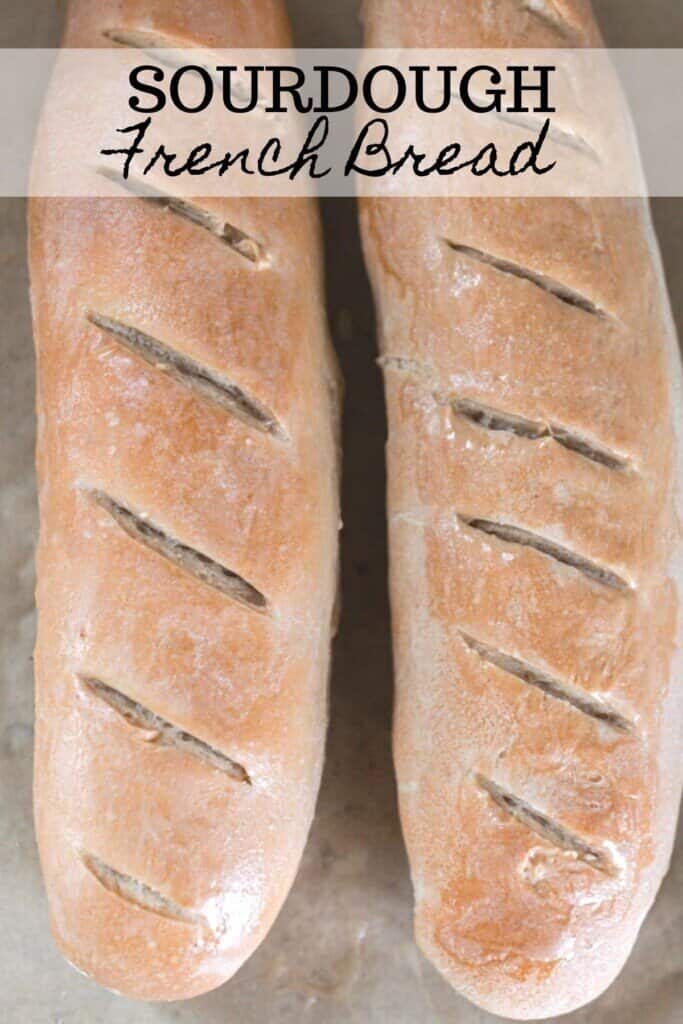
Why you will love this recipe:
- Super simple. Start the night before and allow to ferment and rise overnight. The next day, all you have to do is shape, allow to rise, and bake. It’s a perfect almost-make-ahead side.
- Fermented grains for easier and better digestion. There is no doubt we love sourdough in our house. Not only is it tasty, but the fermentation process helps break down phytic acid, making it more nutritious, and helps break down the gluten, making it easier to digest.
- Delicious. This recipe is everything you love and hope for in a French bread: crusty exterior with a soft and fluffy inside. Use it as a side, garlic bread, or slice it in half to cover with sauce, cheese, and pizza toppings and now you have a pizza bread. This last particular idea was one my mom made us for a quick dinner growing up.
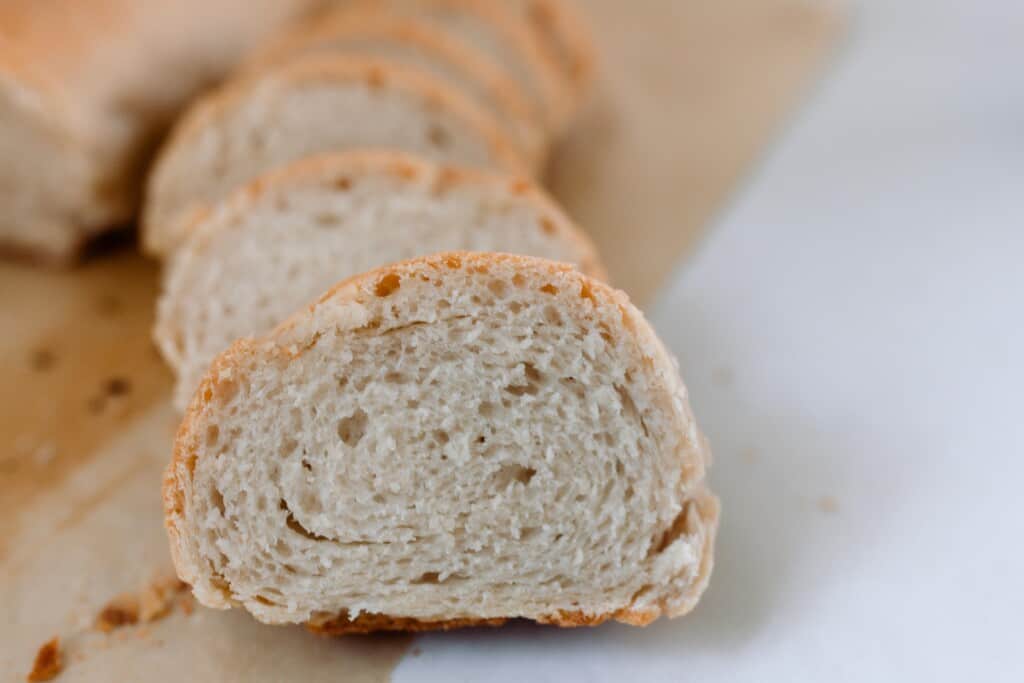
Is French bread the same as sourdough?
No. While they are similar, most French breads are not made with sourdough, but rather with conventional rapid yeast. You can easily make it into sourdough French bread by using this recipe. Just know that most French breads you buy from the store will use yeast.
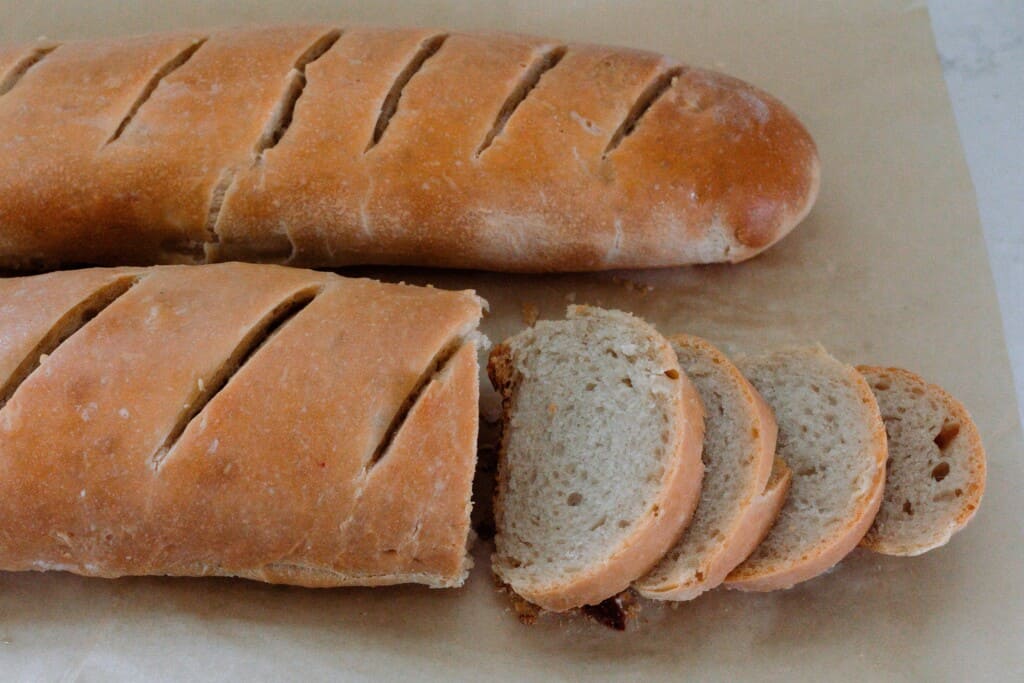
Sourdough French Bread Tips:
- For a soft, fluffy, sourdough bread baguette, your dough should be on the wetter side. A dry dough will leave you with a drier loaf.
- To make those perfect long loaves, I like to roll it out into a rectangle and then roll it up and pinch the ends. This allows for a more even loaf for a better shape and more even baking time.
- To give the baguettes a crustier outside, place a few ice cubes in the oven. This will release steam and achieve that beautiful, golden crust.
- New to sourdough? Learn how to make a starter and care for it. Once you get the hang of it, I promise it is really easy. You can even make a ton of recipes from sourdough discard.
This post contains affiliate links, which means I make a small commission at no extra cost to you. See my full disclosure here.
Tools you may need:
Stand mixer with dough hook.
Measuring cups and spoons
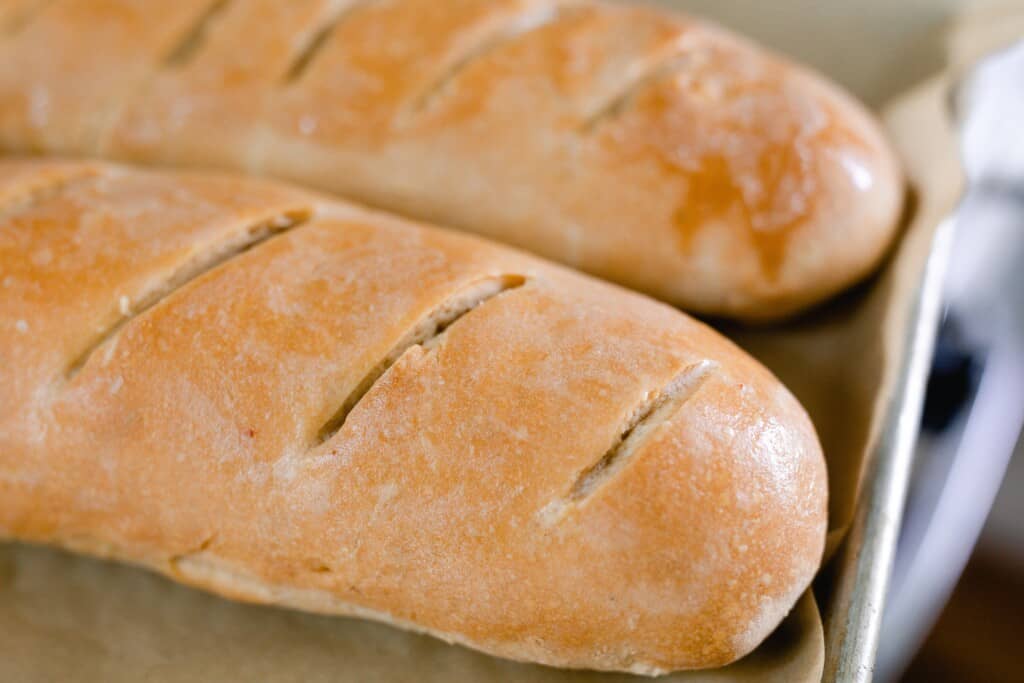
How To Make Sourdough French Bread
Feed your starter 4-12 hours before starting this recipe. It should be very active and bubbly.
To your mixing bowl, add all of the ingredients.
Knead in a stand mixer using the dough hook until stretchy and pulling away from the sides of the bowl. This should take about 5-10 minutes. It should pass the ‘windowpane’ test, which is when you take a small piece of the dough and try to stretch it into a square-like shape. If you can stretch it thin enough where you can “see through it”, then the gluten formation is adequate.
If it doesn’t pass this test and is breaking apart, then place it back into the stand mixer and knead for a few more minutes.
Place in a large, oiled bowl and cover with plastic wrap, beeswax wrap, or something that is airtight. This will keep the dough moist, preventing it from developing a hard skin.
Allow to ferment for 8 to 24 hours in a warm place.
The next day, it should have at least doubled in size.
Punch down the dough. Divide into two equal parts.
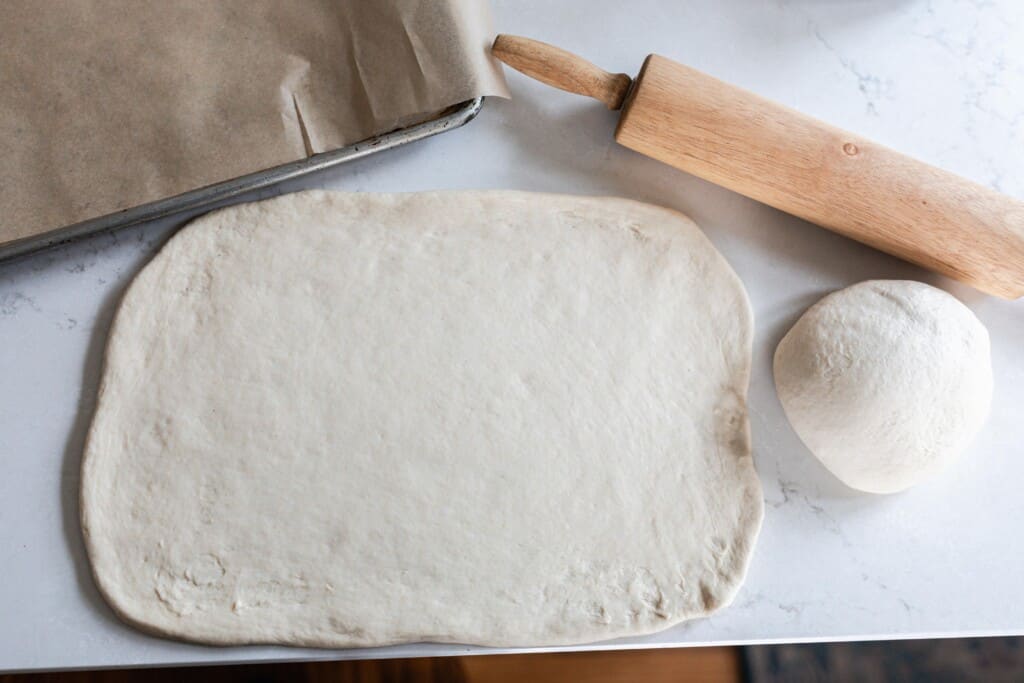
Shape it by rolling the dough into a flat rectangle (about 1/4 – 1/2 inch thickness) and roll up. Pinch the seam.
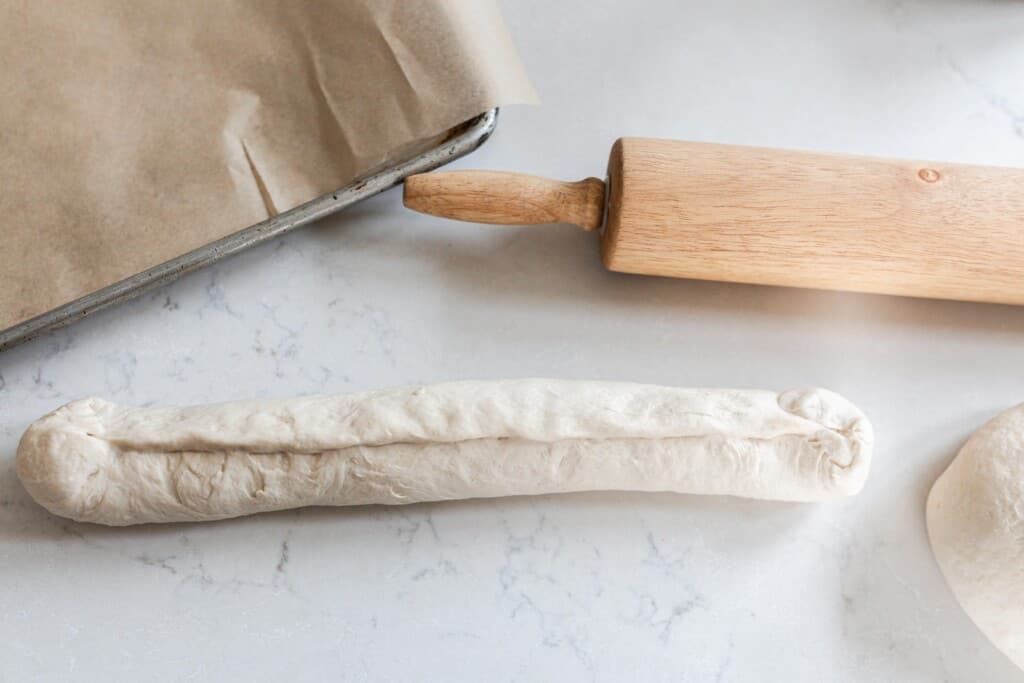
Place French bread dough onto a parchment-lined baking sheet.
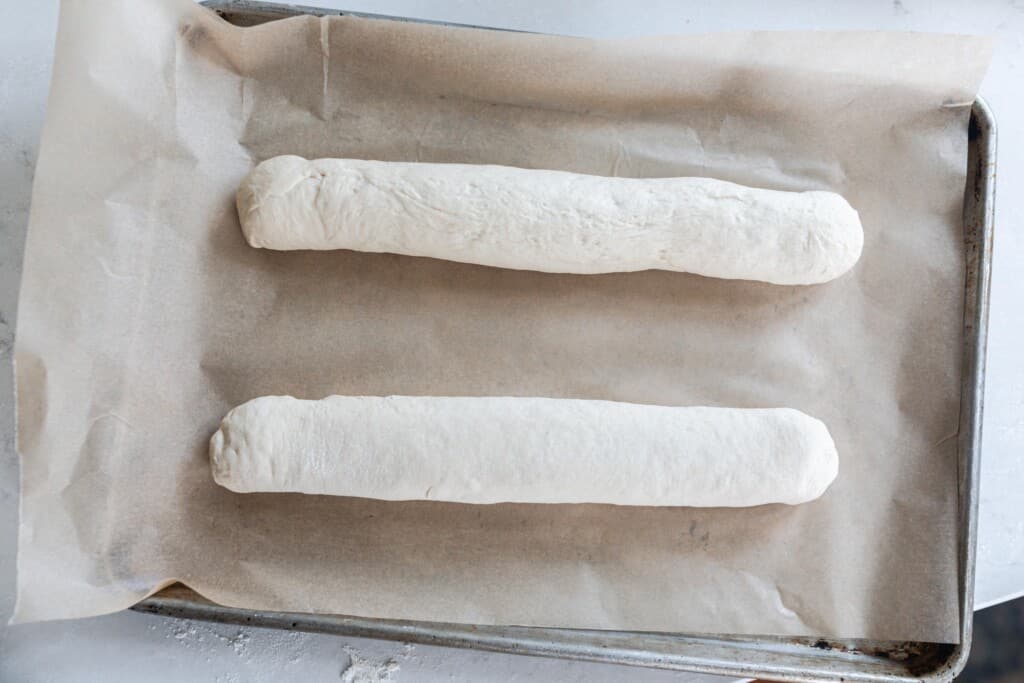
Cover with a towel and allow to rise until doubled again. This could take a few hours depending on how warm your kitchen is.
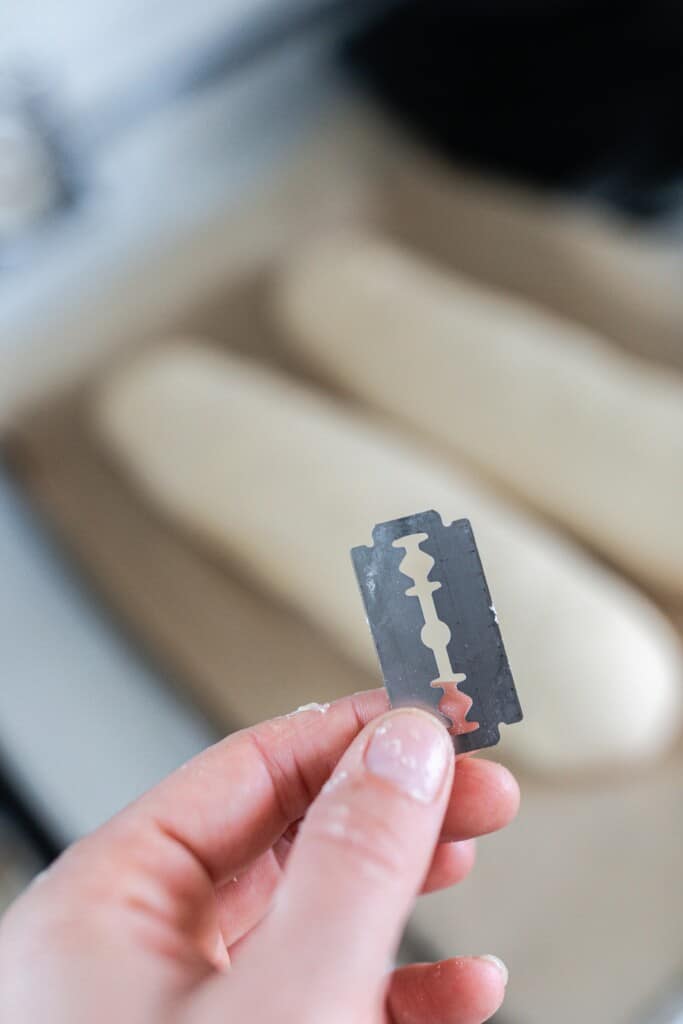
Slash with lame.
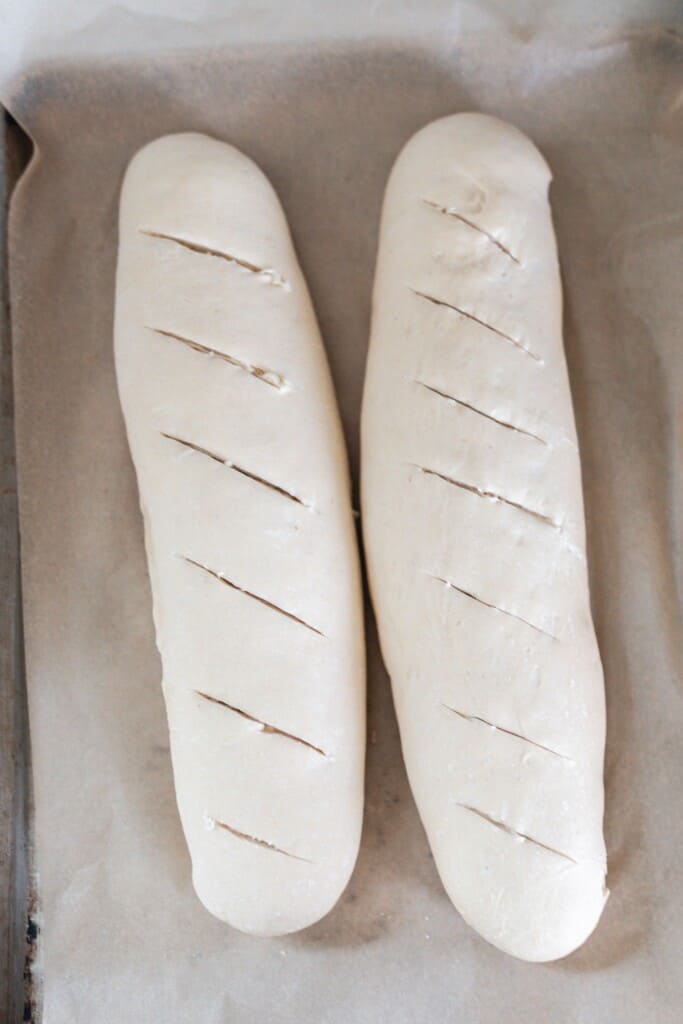
Preheat to 400. Bake for 25 minutes.
For a more golden crust, add ice cubes in the oven. This helps add moisture and steam to make that golden, crustier crust.
Once it is done baking, pull it out of the oven and allow to cool completely before slicing.
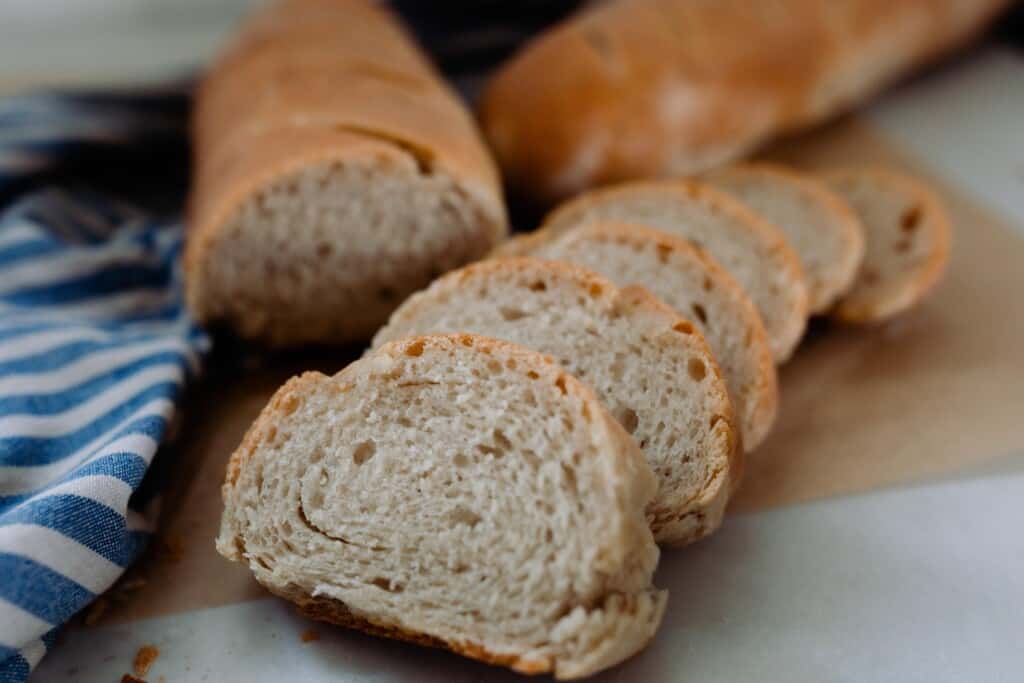
Find More Delicious Sourdough Recipes:
- Sourdough Chocolate Cupcakes
- Sourdough Sandwich Rolls
- No-Knead Sourdough Bread
- Sourdough Blueberry Muffins
- Homemade Sourdough Bagels
If you try this recipe and love it, I would love if you could come back and give it 5 stars! Tag me on Instagram @farmhouseonboone
Sourdough French Bread
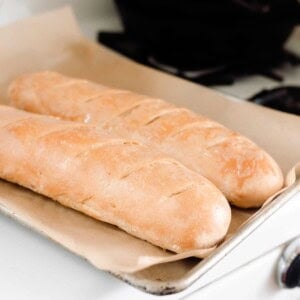
Ingredients
- 1 cup sourdough starter, 227 g
- 1 1/4 cups water, 295 g
- 2 teaspoon salt and, 10 g
- 4 cups all-purpose flour, 560 g
- 1 tablespoon honey, 21 g
- 2 tablespoons olive oil, 27 g
Instructions
- Feed your starter 4-12 hours before starting this recipe. It should be very active and bubbly.
- To your mixing bowl, add all of the ingredients.
- Knead in a stand mixer using the dough hook until stretchy and pulling away from the sides of the bowl. This should take about 5-10 minutes. It should pass the ‘windowpane’ test, which is when you take a small piece of the dough and try to stretch it into a square-like shape. If you can stretch it thin enough where you can “see through it”, then the gluten formation is adequate.
- Place in a large, oiled bowl and cover with plastic wrap, beeswax wrap, or something that is airtight. This will keep the dough moist, preventing it from developing a hard skin.
- Allow to ferment for 8 to 24 hours in a warm place. The next day, it should have at least doubled in size.
- Punch down the dough. Divide into two equal parts.
- Shape it by rolling the dough into a flat rectangle (about 1/4 – 1/2 inch thickness) and roll up. Pinch the seam.
- Place French bread dough onto a parchment-lined baking sheet.
- Cover with a towel and allow to rise until doubled again. This could take a few hours depending on how warm your kitchen is.
- Slash with lame.
- Preheat to 400. Bake for 25 minutes. (For a more golden crust, add ice cubes in the oven. This helps add moisture and steam to make that golden, crustier crust.)
- Once it is done baking, pull it out of the oven and allow to cool completely before slicing.
Notes
- For a more golden crust, add ice cubes in the oven for a crustier crust.
- The windowpane test is when you take a small piece of the dough and try to stretch it into a square-like shape. If you can stretch it thin enough where you can “see through it”, then the gluten formation is adequate. If, after kneading, your dough just breaks apart, then knead it longer until it can pass this test.
Nutrition
Nutrition information is automatically calculated, so should only be used as an approximation.
















Wondering why this calls for all purpose rather than bread flour?
All purpose works great with a sourdough starter. You achieve the rise from the starter, so bread flour isn’t needed.
This was loved by all!! So easy!
Can I make dinner rolls using this recipe?
Yes.
Dough came together nicely and was good to work with – it’s a nice recipe that worked well for me. The only negative was after I shaped the dough and put it on the parchment lined baking sheet to rise before baking I covered it with a tea towel. The dough dried out a bit. Next time I’ll use plastic wrap, a plastic bag or maybe a damp tea towel to prevent that. Because of the dry outside the dough didn’t have the optimum oven spring – it still rose some but I feel it could have been much better had the outside not been so dry. But that’s my error – nothing to do with the recipe. Just a heads up to cover the dough carefully. I will definitely try this one again. Thank you for sharing your recipe.
Mine doubled in 5 hours. I’m assuming that’s okay right? I shouldn’t wait the 8-12 if it doubles before then right ?
Yes, that’s fine. You move forward after 5 hours!
Made these for homemade Italian meatball subs and they turned out great! It took 12 hours for the dough to double in my ~67 degree kitchen, so I can’t imagine what temp would require a 24 hour rise. Glad I checked last night or it would have been super over proofed! I formed the loaves and put in the fridge overnight, then took them out in the morning to rise and baked around 4:30pm.
I’ve made this recipe a few times and I have some issues with the dough keeping its shape and splitting (at the base) when it’s baked. Do you know why that might happen? At first, I thought it was underproved, but it doesn’t have any other signs of being underproved. Maybe the gluten isn’t developed enough?
The taste is amazing though!! Literally, my husband told me “I could eat this at every meal”
Absolutely loved this recipe
I made this recipe 2 months into my sourdough journey and it was amazing! We ate it with New Orleans bbq shrimp. It was perfect for dipping in the sauce.
I’m going to make it again tonight and I can’t wait to see how the process goes now that I feel like I know what I’m doing – 8 months later.
My starter was fed at 2pm yesterday and this morning it is still very bubbly. I will make the dough and put it in the fridge tonight since we won’t be eating until tomorrow evening. I’m excited to see how the flavor develops.
Used ice cubes but didn’t get a golden crust.
Should I have spritzed with water first?
That could help too.
Help! I am having trouble with my dough being extremely sticky and soupy. Especially during the shaping phase. I thought it was because I use only AP flour and so I was intending to get bread flour, which I will anyway, however this recipe only calls for AP flour so I’m not sure what’s going on. My starter is very active and bubbly, it passes the float test, but I also think it’s super high hydration starter. It typically struggles during the mixing/kneeding phase as well. It rarely pulls from the side of the bowl and takes a very long time for it to even get close. I have added flour before in this step just to get it to hold some texture (which I’m sure I’m not supposed to do?). I am not sure what else to do and it’s getting kind of frustrating that it’s a consistent problem. What tips or help can you give me?
Your environment/climate may need a little more flour! You could also feed your starter 3/4 cup water to 1 cup flour, in that ratio. Those two things should help you.
There’s also an inconsistentcy between the amount of flour vs weight…is the correct measurement 4 cups (480g) or 560g (roughly 4 2/3 cups)?
Depends on how you measure it, but it is probably closer to 560! It’s not enough weight to really make a difference!